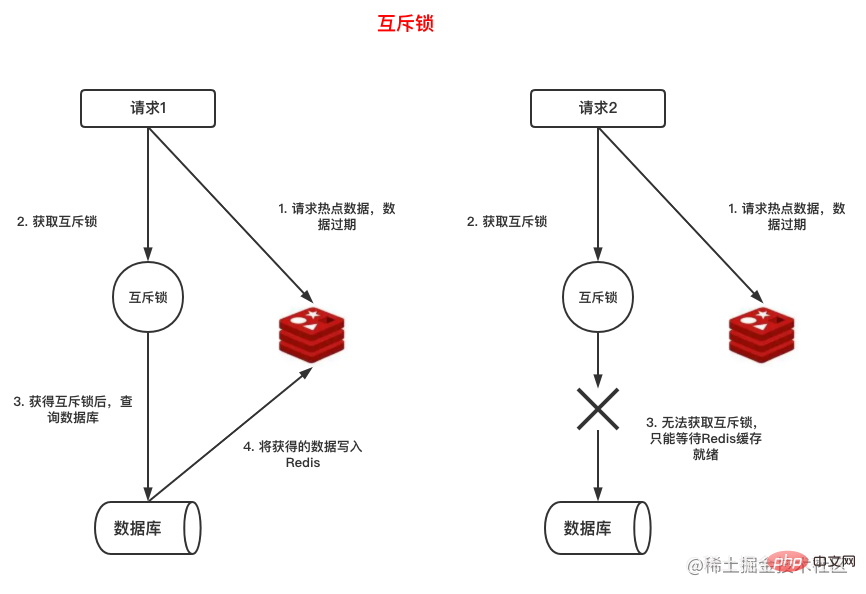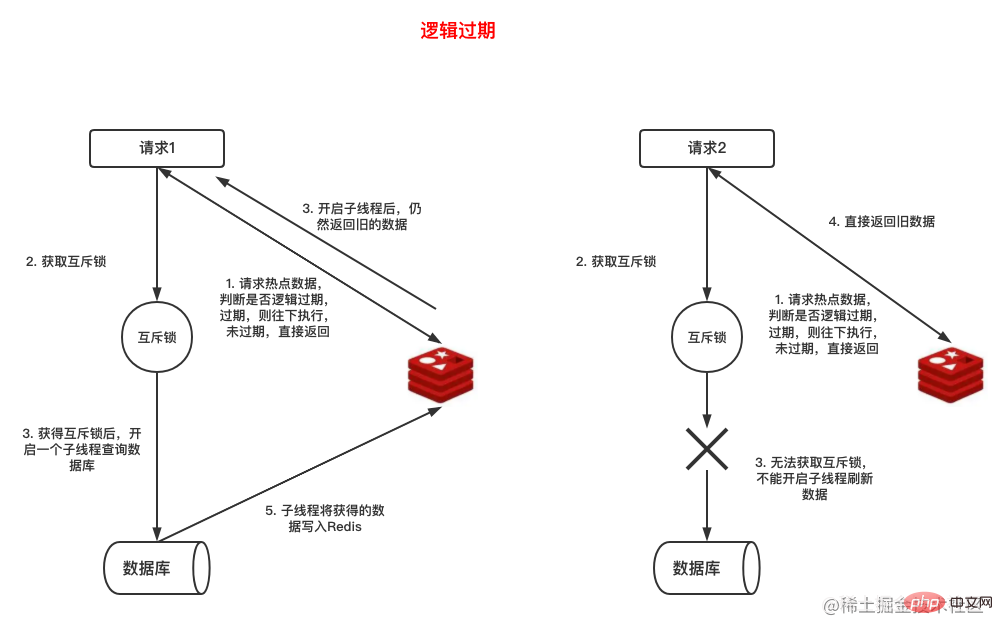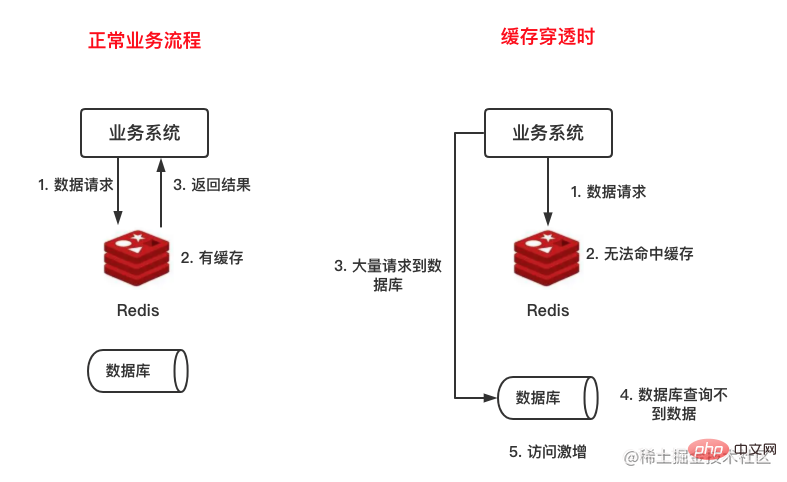How to solve Redis cache avalanche, breakdown and penetration
This article brings you relevant knowledge about Redis, which mainly introduces how to solve the problems related to redis cache avalanche, breakdown and penetration. Cache avalanche refers to a large number of requests. The cached data in Redis cannot be hit, that is, the data cannot be found in Redis. Let's take a look at it, I hope it will be helpful to everyone.

Recommended learning: Redis video tutorial
1. Cache avalanche
1. What is Cache avalanche?
Cache avalanche refers to a large number of requests that cannot hit the cached data in Redis, that is, the data cannot be found in Redis , then the business system can only query the database, which will cause all requests to be sent to the database. As shown in the figure below:

The database is not as capable of handling a large number of requests as Redis. The surge in requests caused by cache avalanche will definitely cause the database to go down. , This will inevitably affect the business system, so if a cache avalanche occurs, it will definitely be fatal to the business system.
2. Why does cache avalanche occur?
Under what circumstances does a cache avalanche occur? To sum up, there are two reasons:
A large number of
Rediscached data expired at the same time, causing all requests sent toRedisto fail. Hit data can only be queried in the database.RedisThe server is down, all requests cannot be processed throughRedis, and can only be turned to the database to query data.
3. How to avoid cache avalanche?
There are different solutions to the causes of cache avalanche:
For a large number of random cache expiration times, the solution is to add the original expiration time to Add a random expiration time, such as a random expiration time between 1 and 5 minutes, to avoid a large amount of cached data expiring at the same time.
To solve the cache avalanche caused by
Redis, you can set up theRedismaster-slave server in advance for data synchronization, and Configure the sentinel mechanism so that when theRedisserver is unable to provide services due to downtime, the sentinel can set theRedisslave server to the master server and continue to provide services.
2. Cache breakdown
1. What is cache breakdown
Cache breakdown is similar to cache avalanche. The avalanche is caused by a large number of The data has expired, and cache breakdown refers to the expiration of hotspot data. All requests for hotspot data need to be processed in the database, as shown in the following figure:

2 . How to avoid cache penetration?
Three ways to solve cache breakdown:
- Do not set expiration time
If we can know in advance that a certain data is hot data, then You can not set the expiration of these data to avoid cache breakdown problems. For example, some products in flash sales will be accessed by a large number of users during the flash sale. At this time, we can write the product data for flash sales into the cache in advance and not Set expiration time.
- Mutex lock
If we know in advance that certain data will be accessed in large quantities, of course we can set it to not expire, but more often than not, we cannot predict it in advance. How to deal with this situation?
Let’s analyze the cache breakdown situation:
Under normal circumstances, when a certain Redis cached data expires, if there is a request for the data, then Re-query in the database and write to the cache so that subsequent requests can hit the cache without querying the database again.
When the hotspot data expires, due to a large number of requests, when a request cannot hit the cache, the database will be queried and the data will be rewritten to Redis, that is, writing RedisBefore, when other requests came in, the database would also be queried.
Okay, we know that after the hotspot data expires, many requests will query the database, so we can add a mutex lock to the business logic of querying the database. Only requests that obtain the lock can query the database and put The data is written back to Redis, while other requests that have not obtained the lock can only wait for the data to be ready.
The above steps are shown in the figure below:

- Set logical expiration time
Although using a mutex lock can solve the cache breakdown problem very simply, requests that do not obtain the lock are queued up, which affects the performance of the system. , and another way to solve cache breakdown is to add an expiration time to the business data redundancy. For example, in the following data, we have added the expire_at field to indicate the data expiration time.
{"name":"test","expire_at":"1599999999"}复制代码The implementation process of this method is shown in the figure below:

The hotspot data in the cache has a redundant logical expiration time, but the data is RedisDo not set expiration time
When a request gets the data in Redis, determine whether the logical expiration time has expired. If it has not expired, return directly. If When it expires, another thread is opened to obtain the lock, query the database and write the latest queried data back to Redis, and the current request returns the queried data.
3. Cache penetration
1. What is cache penetration
Cache penetration means that the data to be found is neither in the cache nor in the database, because It is not in the cache, so the request will definitely reach the database. RedisThe cache is in name only, as shown in the following figure:

2. Why does cache penetration occur
Under what conditions will cache penetration occur? There are mainly three situations:
Malicious user attack request
Malicious operation of
Redisand the data in the database DeletedWhen the user has not yet generated content, such as the user's article list, the user has not written an article, so there is no data in the cache and database
3. How to avoid cache penetration?
a. Cache empty value or default value
When no data can be queried in the Redis cache, query it from the database again. If there is no data, directly Cache a space or default value to avoid querying the database next time; however, in order to prevent the database from responding to the database and then returning a null value, the expiration time should be set for the cache, or the corresponding data should be cleared directly when the data is generated. Cache empty values.
b. Bloom filter
Although caching null values can solve the cache penetration problem, it still needs to query the database once to determine whether there is data. If there is a malicious attack by a user, high concurrency Querying using data IDs that do not exist in the system requires all queries to go through the database, which will still put a lot of pressure on the database.
So, is there any way to determine whether the data exists without querying the database? Yes, use Bloom filter.
The Bloom filter mainly consists of two parts: bit array N hash functions. The principle is:
Use N hash functions to mark the The data is hashed.
Take the calculated hash value modulo the length of the bit array, so that the position of each hash value in the bit array can be obtained.
Mark the corresponding position in the bit array as 1.
The following is a schematic diagram of the Bloom filter principle:

When data is to be written, perform the steps described above and calculate Corresponds to the bit array position and is marked as 1, then when executing the query, you can check whether the data exists.
In addition, due to errors caused by hash collision problems, non-existent data will be judged to exist after passing through the Bloom filter, and then the database will be checked. However, the probability of hash collision is very small. Using Bloom filters can already help us intercept most penetration requests.
Redis itself supports Bloom filters, so we can directly use Redis Bloom filters without having to implement them ourselves, which is very convenient.
4. Summary
Cache avalanche, breakdown, and penetration are cache exception problems that are often encountered when caching business applications. The causes and solutions are as follows:
| Problem | Cause | Solution |
|---|---|---|
| Cache Avalanche | A large amount of data expires orRedisserver crashes |
1. Random expiration time 2. Master-slave sentinel cluster |
| Cache breakdown | Hotspot data expiration | 1. Do not set expiration time 2. Add mutex lock 3. Redundant logical expiration time |
| Cache penetration | Request data that is not available in the database and Redis
|
1. Cache empty value or default value 2. Bloom filter |
Recommended learning: Redis video tutorial
The above is the detailed content of How to solve Redis cache avalanche, breakdown and penetration. For more information, please follow other related articles on the PHP Chinese website!

Hot AI Tools

Undresser.AI Undress
AI-powered app for creating realistic nude photos

AI Clothes Remover
Online AI tool for removing clothes from photos.

Undress AI Tool
Undress images for free

Clothoff.io
AI clothes remover

Video Face Swap
Swap faces in any video effortlessly with our completely free AI face swap tool!

Hot Article

Hot Tools

Notepad++7.3.1
Easy-to-use and free code editor

SublimeText3 Chinese version
Chinese version, very easy to use

Zend Studio 13.0.1
Powerful PHP integrated development environment

Dreamweaver CS6
Visual web development tools

SublimeText3 Mac version
God-level code editing software (SublimeText3)

Hot Topics
 1387
1387
 52
52
 How to build the redis cluster mode
Apr 10, 2025 pm 10:15 PM
How to build the redis cluster mode
Apr 10, 2025 pm 10:15 PM
Redis cluster mode deploys Redis instances to multiple servers through sharding, improving scalability and availability. The construction steps are as follows: Create odd Redis instances with different ports; Create 3 sentinel instances, monitor Redis instances and failover; configure sentinel configuration files, add monitoring Redis instance information and failover settings; configure Redis instance configuration files, enable cluster mode and specify the cluster information file path; create nodes.conf file, containing information of each Redis instance; start the cluster, execute the create command to create a cluster and specify the number of replicas; log in to the cluster to execute the CLUSTER INFO command to verify the cluster status; make
 How to clear redis data
Apr 10, 2025 pm 10:06 PM
How to clear redis data
Apr 10, 2025 pm 10:06 PM
How to clear Redis data: Use the FLUSHALL command to clear all key values. Use the FLUSHDB command to clear the key value of the currently selected database. Use SELECT to switch databases, and then use FLUSHDB to clear multiple databases. Use the DEL command to delete a specific key. Use the redis-cli tool to clear the data.
 How to read redis queue
Apr 10, 2025 pm 10:12 PM
How to read redis queue
Apr 10, 2025 pm 10:12 PM
To read a queue from Redis, you need to get the queue name, read the elements using the LPOP command, and process the empty queue. The specific steps are as follows: Get the queue name: name it with the prefix of "queue:" such as "queue:my-queue". Use the LPOP command: Eject the element from the head of the queue and return its value, such as LPOP queue:my-queue. Processing empty queues: If the queue is empty, LPOP returns nil, and you can check whether the queue exists before reading the element.
 How to use the redis command
Apr 10, 2025 pm 08:45 PM
How to use the redis command
Apr 10, 2025 pm 08:45 PM
Using the Redis directive requires the following steps: Open the Redis client. Enter the command (verb key value). Provides the required parameters (varies from instruction to instruction). Press Enter to execute the command. Redis returns a response indicating the result of the operation (usually OK or -ERR).
 How to use redis lock
Apr 10, 2025 pm 08:39 PM
How to use redis lock
Apr 10, 2025 pm 08:39 PM
Using Redis to lock operations requires obtaining the lock through the SETNX command, and then using the EXPIRE command to set the expiration time. The specific steps are: (1) Use the SETNX command to try to set a key-value pair; (2) Use the EXPIRE command to set the expiration time for the lock; (3) Use the DEL command to delete the lock when the lock is no longer needed.
 How to read the source code of redis
Apr 10, 2025 pm 08:27 PM
How to read the source code of redis
Apr 10, 2025 pm 08:27 PM
The best way to understand Redis source code is to go step by step: get familiar with the basics of Redis. Select a specific module or function as the starting point. Start with the entry point of the module or function and view the code line by line. View the code through the function call chain. Be familiar with the underlying data structures used by Redis. Identify the algorithm used by Redis.
 How to solve data loss with redis
Apr 10, 2025 pm 08:24 PM
How to solve data loss with redis
Apr 10, 2025 pm 08:24 PM
Redis data loss causes include memory failures, power outages, human errors, and hardware failures. The solutions are: 1. Store data to disk with RDB or AOF persistence; 2. Copy to multiple servers for high availability; 3. HA with Redis Sentinel or Redis Cluster; 4. Create snapshots to back up data; 5. Implement best practices such as persistence, replication, snapshots, monitoring, and security measures.
 How to use the redis command line
Apr 10, 2025 pm 10:18 PM
How to use the redis command line
Apr 10, 2025 pm 10:18 PM
Use the Redis command line tool (redis-cli) to manage and operate Redis through the following steps: Connect to the server, specify the address and port. Send commands to the server using the command name and parameters. Use the HELP command to view help information for a specific command. Use the QUIT command to exit the command line tool.




